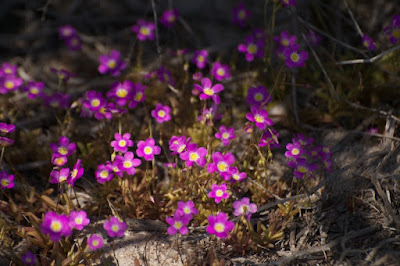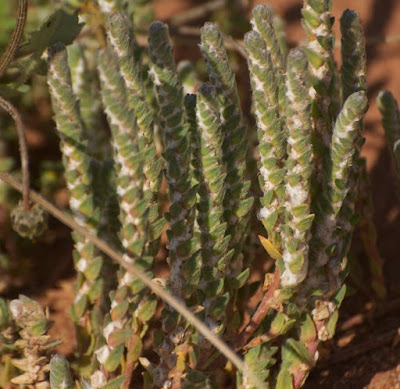One of the problems I have in writing up long, event-filled and heavily-photographed days is the need to break them up, for the benefit of my long-suffering readers, into bite-sized chunks. Consider this further installment of our adventures on September 16, 2013, as the equivalent of a nibble - a look further east, past the colony of Wreath Flowers I featured in my last post, to the end of the road leading to the Mount Gibson Extension Hill Iron Mine. This was our furthest reach into Australia's central deserts, the area botanists refer to as the Eremaean Province.
This is, at least as you speed past it in an automobile, rather barren and featureless country. I am sure, though, that a naturalist on his hands and knees could turn up all sorts of interesting minutiae: insects, lizards or perhaps a scorpion or two (not the sorts of things likely to warm the hearts of my flower-seeking companions, mind you).
In this case, it is a stand of Round-leaved Pigface (Disphyma crassifolium). Though a native plant, this is not - unlike so many other southwestern plants - an endemic. Besides being widespread in Australia, it also grows widely in New Zealand and South Africa. Pigfaces belong to the Aizoaceae, a family of succulent plants with thick, water-storing leaves. Members of the family can be found in deserts, or along the edge of the sea where they are particularly resistant to salt spray.
More thinly scattered on the ground, but equally startling against the khaki of the desert earth, are the parakeelyas, Australian members of the portulaca family (Portulacaceae).
The many species are hard to identify (well, I find them so), but these may be Round-leaved Parakeelya (Calandrinia remota). "Parakeelya", by the way, is an aboriginal name for these plants; the roots and leaves are edible, something that inhabitants of the dry centre must have greatly appreciated.
Other plants in the desert near the mine entrance were, on the whole, less eye-catching, though this little shrub at least sports a somewhat washed-out version of the parakeelyas' pink. Cotton Bush (Ptilotus obovatus), a widespread plant of the central deserts, is (as its name implies) densely hairy, an adaptation (as I have said before) to reflecting away the burning rays of the desert sun.
The many species are hard to identify (well, I find them so), but these may be Round-leaved Parakeelya (Calandrinia remota). "Parakeelya", by the way, is an aboriginal name for these plants; the roots and leaves are edible, something that inhabitants of the dry centre must have greatly appreciated.
Other plants in the desert near the mine entrance were, on the whole, less eye-catching, though this little shrub at least sports a somewhat washed-out version of the parakeelyas' pink. Cotton Bush (Ptilotus obovatus), a widespread plant of the central deserts, is (as its name implies) densely hairy, an adaptation (as I have said before) to reflecting away the burning rays of the desert sun.
Ptilotus flowers are also known as mulla mullas, one of their aboriginal names. This one is Green Mulla Mulla, or Prince of Wales Feather (Ptilotus polystachyus). The genus belongs to the amaranth family (Amaranthaceae).
The odd-looking Cottony Bluebush (Maireana carnosa) is another desert plant that takes its English name from its coat of hairs. It is a member of the goosefoot family (Chenopodiaceae).
Even odder-looking, perhaps, is this plant, another (which one?) of the goosefoots. Chenopods are wide-ranging and varied in the Australian interior.
Of course, you don't have to be a desert specialist to grow out here, as this clump of Capeweed (Arctotheca calendula), a South African exotic widespread in Australia, proves. This, though, is about as far into the desert as this particular plant gets.
This is, though, still harsh country. In a few weeks the flowers that add a touch of softness to the landscape will be gone, leaving only their seeds to wait for next year's rains. As I write this account, almost two years after our visit, the remaining bones of this kangaroo will surely have bleached white in the sun; in a couple of months, though, the desert flowers, descendants of those in these photographs, will be blooming again. At least I hope so.




















No comments:
Post a Comment